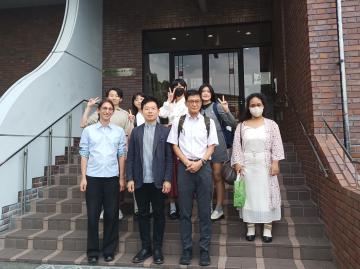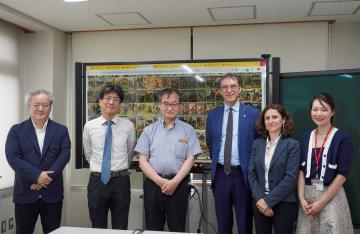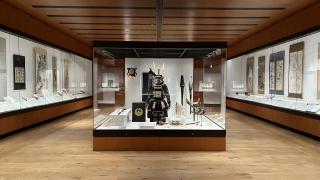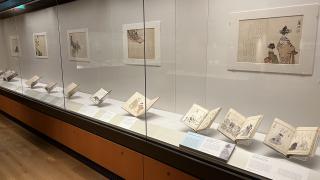-
2024年7月3日(水)18:00より、Web配信にて第136回国際ARCセミナーを開催いたします。
プログラムは下記となります。
講師:石井 真美子氏(立命館大学 文学部中国文学・思想専攻 教授)
タイトル:「祇園祭と中国古典文学」
日時:2024年7月3日(水)18:00~19:30
参加:Zoom配信(関係者のみ・予約不要)
※クローズドイベントのため、YouTube配信はございません。
2024年6月26日(水)18:00より、Web配信にて第135回国際ARCセミナーを開催いたします。
プログラムは下記となります。
講師:
町田 樹氏 (國學院大學 准教授)
栗原 祐司氏(国立科学博物館 副館長・理事)
新名 佐知子氏(秩父宮記念スポーツ博物館・図書館)タイトル:「日本のスポーツアーカイブを未来へと継承するために」
日時:2024年6月26日(水)18:00~19:30
参加:Zoom配信(関係者のみ・予約不要)
※ARCメンバー以外の方は Youtubeよりご参加いただけます。こちらからご覧下さい。

2024年6月20日、台湾国立政治大学がアート・リサーチセンター(ARC)を見学されました。
ARCの建物やデジタルアーカイブ施設を見学されたほか、Travis Seifman氏(現ARCリサーチマネージャー/立命館大学衣笠総合研究機構・准教授)によるARCのDH研究活動に関する紹介を行いました。
カリフォルニア大学バークレー校 日本研究センター(CJS)と、立命館大学アート・リサーチセンター(ARC) 共催のもと、第二回 合同コロキウム「アメリカから研究する日本、海外に発信する日本研究」を開催します。
日時: 2024年6月21日(金) 14:00-17:30
会場: 立命館大学アート・リサーチセンター(ARC)+ZOOM (※closedな研究会として行われます)協力:立命館大学アート・リサーチセンター 文部科学省国際共同利用・共同研究拠点「日本文化資源デジタル・アーカイブ国際共同研究拠点」
プログラム (予定)
続きを読む>>2024年6月12日(水)18:00より、Web配信にて第134回国際ARCセミナーを開催いたします。
プログラムは下記となります。
講師:高野 光平氏(茨城大学人文社会科学部現代社会学科 教授)
タイトル:「20世紀のテレビCMデータベースについて」
日時:2024年6月12日(水)18:00~19:30
参加:Zoom配信(関係者のみ・予約不要)
※クローズドイベントのため、YouTube配信はございません。
立命館大学アート・リサーチセンター(ARC)では、国際共同研究プロジェクトの活動支援の一つとして、米国のESRI社のGISプラットフォーム(ArcGIS)で利用できるArcGIS Onlineアカウントの提供を行っています。国際共同研究プロジェクトのメンバーは、以下の条件で当センターが発行するアカウントを利用できます。希望者は、ml-tech-support[ at ]ml.ritsumei.ac.jpに、ご連絡ください([ at ]は@へ置き換えてください。)。この際、メールの件名を「ArcGIS Onlineアカウントの発行希望」とし、本文に1. 氏名(英語表記も追記)、2. 登録プロジェクト名、3. メールアドレスを記載してください。
- 国際共同研究プロジェクトに登録している研究者(分担者、院生含む)。
※国際共同研究プロジェクトにまだ登録されていない場合は、まず、国際共同研究プロジェクト〔研究設備・資源活用型〕[D]の申請書をご提出ください。なお、国際共同研究課題教育実践の目的とした場合は、国際共同研究課題〔ARCシステム教育実践活用〕[E] の申請書をご提出ください。→詳細はこちらです。
- 発行するアカウントは、一人一アカウントとなります。
- 各ユーザーは、250クレジットを使用できます。※追加を希望する場合は別途ご相談ください。
- 本アカウントは年度ごとに更新が必要となります。
- 登録者の上限に達した場合、お申込みいただいてもアカウントの発行や、年度をまたぐ継続利用ができない場合があります。2024年5月22日(水)18:00より、Web配信にて第133回国際ARCセミナーを開催いたします。
プログラムは下記となります。
講師:高野 明彦氏(立命館大学衣笠総合研究機構 招聘研究教員(客員教授))
タイトル:「デジタルアーカイブを用いた探求学習のための教材作成について」
日時:2024年5月22日(水)18:00~19:30
参加:Zoom配信(関係者のみ・予約不要)
※ARCメンバー以外の方は Youtubeよりご参加いただけます。こちらからご覧下さい。
この度、立命館大学アート・リサーチセンター(ARC)は、加藤周一現代思想研究センターと提携し、立命館大学図書館が所蔵する加藤周一文庫の「資料閲覧データベース」と「資料検索システム」を公開しました。
「加藤周一文庫 資料閲覧データベース」
https://www.dh-jac.net/db1/resource/search_2023i05.php「加藤周一文庫 資料検索システム」
https://www.dh-jac.net/db1/resource/search_KSB2023i05.php加藤周一(1919年~2008年)は、戦後日本を代表する国際的知識人であり、洋の東西にわたる該博な知識と広い視野のもとに日本文学史や日本美術史を研究しました。
2015年に設立された「加藤周一現代思想研究センター」は、立命館大学図書館加藤周一文庫に収められた膨大な蔵書と遺稿類の研究およびそこで得られた知見の社会への発信・活用、国際的知識人の育成をその活動目的としています。
加藤周一文庫の「資料閲覧データベース」と「資料検索システム」はARCによって開発・公開され、オンライン上での研究活動を支援するためのシステムとして運用されています。
関連URL:
加藤周一現代思想研究センター:https://www.ritsumei.ac.jp/research/center/kato_shuichi/
この度、イギリス・ロンドンにある大英博物館では、日本学術振興会(JSPS)および英国研究・イノベーション機構(UK Research and Innovation, UKRI)の助成による国際共同研究プロジェクト「上方文化サロン:人的ネットワークから解き明かす文化創造空間 1780-1880」の研究成果を紹介する1年間の特別展示が開催されています。
立命館大学アート・リサーチセンター(ARC)センター長の赤間亮教授と大英博物館アジア部学芸員の矢野明子博士を研究代表者とするこの研究プロジェクトは、大英博物館、そして日本各地に所蔵されている5,000点を超える作品を分析することで、前近代日本、特に1780年から1880年頃の京阪神地域で発達した“上方文化サロン”や文化創生における集団制作(合作)システムの文化的・社会的影響を調査・分析し、高度な文化成熟が成立するメカニズムを解明することを目的としています。
本プロジェクトでは、ARCが構築・運営するオンライン型研究システム「上方文化人総合データベース」に、これらの作品を登載しました。このシステムは、研究活動に活用できる前近代日本文化研究の新たなポータルとして、複数のデータベースにより構成されています。将来的に同様の形で異なるテーマのポータルを追加することも可能です。
→ARCバーチャル・インスティテュート:「上方文化サロンとネットワーク 1780年~1880年」
COVID-19の課題に取り組むこのプロジェクトは、立命館大学アート・リサーチセンター、関西大学、京都国立近代美術館、大英博物館、ロンドン大学東洋アフリカ研究院(SOAS)の研究者チームから構成され、オンライン・デジタル技術を駆使した日英共同研究の効率的な進め方の模範となっています。
また本プロジェクトは、国際的な研究環境の中で日英の若手研究者にデジタル・ヒューマニティーズの基礎を学ぶ機会を提供し、日本研究の若手研究者育成に貢献しました。
本研究は、日本学術振興会国際共同研究事業英国との国際共同研究プログラム(JRP-LEAD with UKRI)[課題番号JPJSJRP 20211708]による支援を受けたものです。
実施期間: 2021年12月1日~2024年11月30日(3年間)
関連記事:https://www.britishmuseum.org/research/projects/making-art-together-japan
続きを読む>>
















